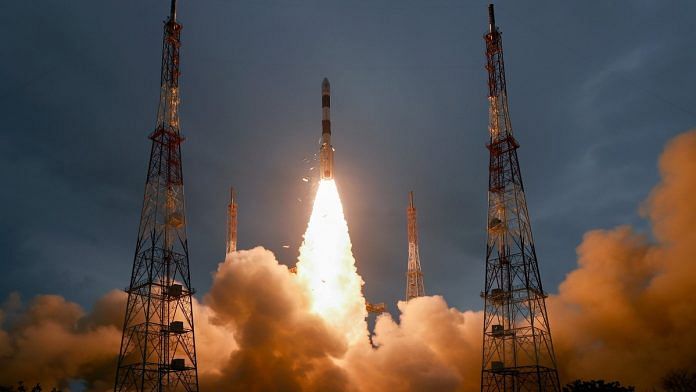Bengaluru: The Indian Space Research Organisation (ISRO) Wednesday launched its advanced earth observation satellite, Cartosat-3, and 13 American nano-satellites from its second launch pad at Sriharikota. The satellites were on-board the PSLV-C47 and the launch occurred at 9.28am.
This was the PSLV’s 49th mission. The PSLV-C47 is the 21st flight of PSLV in the ‘XL’ configuration (with six solid strap-on motors). This was also the 74th launch vehicle mission from the Satish Dhawan Space Centre (SDSC) SHAR, Sriharikota.
The launch vehicle placed the Cartosat-3 in an orbit of 509 km at an inclination of 97.5 degrees. The other satellites were separated a minute later in quick succession at a height between 516 km and 527 km.
Also read: ISRO has a data mine that can help save lives. More people should have access to it
An advanced satellite
The Cartosat-3 is a third-generation advanced satellite with very high resolution imaging capability.
The 1625 kg Cartosat-3 is the ninth satellite to be launched in the Cartosat series and will be used for earth observation and imaging. The series has been active since 2005 with the launch of Cartosat-1 and will form a part of ISRO’s observation system called the Indian Remote Sensing Programme (IRS).
The satellites are used for not just cartography or weather mapping but also to assist the military, for forest surveys, urban planning, coastal studies and mineral prospecting, among others. Most importantly, they are used for disaster relief assistance.
The 13 customer satellites have been launched as a part of a commercial arrangement with NewSpace India Limited (NSIL), Department of Space. 12 of them are FLOCK-4P for earth observation and one is the MESHBED, which will operate as a communication testbed. Both have been sent by private American companies.
Also read: Astronomers observe strongest gamma ray bursts — explosions with more energy than ever
Best resolution in orbit
Cartosat-3 is a very high resolution panchromatic, multispectral, hyperspectral satellite.
Multispectral indicates that the satellite can see in 3 to 10 bands of the electromagnetic spectrum; the satellite’s multispectral resolution is 1.13 m with 16 km swath in four bands.
Hyperspectral indicates hundreds of thousands of narrow bands being imaged; the satellite’s hyper spectral resolution is 12 m with 5 km swath.
Where Cartosat-3 stands out is in its panchromatic resolution. Panchromatic indicates its sight in the visible part of the spectrum; Cartosat-3 has a ground resolution of 0.25 m with 16 km swath. The satellite can pick out an object that is 25-cm long in a 16-km wide area.
It is the highest resolution camera ever built by ISRO and is the best panchromatic resolution camera in orbit today known commercially. It replaces WorldView-4, an American satellite with a resolution of 31cm.
Also read: Meet Bala Iyer, theoretical physicist leading advanced gravitational-wave project for India
A heavier satellite
The satellite is also more than double the mass of nearly all of the previous satellites in its series. Cartosat-1 weighed 1,560 kg but Cartosat-2 to Cartosat-2F have all been under 800kg in weight.
It also contains newer technologies including newer sensors and high data rate transmitters, and is described by ISRO as being “highly agile”. The navigation processor chip is called Vikram-1601 and was manufactured in India.
ISRO states that the satellite will address increased user demands for large-scale urban planning, rural resource and infrastructure development, coastal land use, and land cover, among other applications.
Also read: First map of Saturn’s largest moon Titan revealed, shows features similar to Earth



